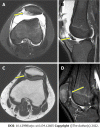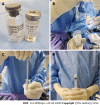Repair of a large patellar cartilage defect using human umbilical cord blood-derived mesenchymal stem cells: A case report
- PMID: 36579106
- PMCID: PMC9791508
- DOI: 10.12998/wjcc.v10.i34.12665
Repair of a large patellar cartilage defect using human umbilical cord blood-derived mesenchymal stem cells: A case report
Abstract
Background: Patellar dislocation may cause cartilage defects of various sizes. Large defects commonly require surgical treatment; however, conventional treatments are problematic.
Case summary: A 15-year-old male with a large patellar cartilage defect due to patellar dislocation was treated via human umbilical cord blood-derived mesenchymal stem cell (hUCB-MSC) implantation. To our knowledge, this is the first report of this treatment for this purpose. The patient recovered well as indicated by good visual analog scale, International Knee Documentation Committee and McMaster Universities Osteoarthritis Index scores. Magnetic resonance imaging showed cartilage regeneration 18 mo postoperatively.
Conclusion: Umbilical cord blood-derived hUCB-MSCs may be a useful treatment option for the repair of large patellar cartilage defects.
Keywords: Cartilage defect; Case report; Magnetic resonance imaging; Mesenchymal stem cells; Patellar dislocation; Umbilical cord.
©The Author(s) 2022. Published by Baishideng Publishing Group Inc. All rights reserved.
Conflict of interest statement
Conflict-of-interest statement: All authors report no relevant conflict of interest for this article.
Figures




References
-
- Gracitelli GC, Meric G, Pulido PA, Görtz S, De Young AJ, Bugbee WD. Fresh osteochondral allograft transplantation for isolated patellar cartilage injury. Am J Sports Med. 2015;43:879–884. - PubMed
-
- Nomura E, Inoue M, Kurimura M. Chondral and osteochondral injuries associated with acute patellar dislocation. Arthroscopy. 2003;19:717–721. - PubMed
-
- Park YB, Song M, Lee CH, Kim JA, Ha CW. Cartilage repair by human umbilical cord blood-derived mesenchymal stem cells with different hydrogels in a rat model. J Orthop Res. 2015;33:1580–1586. - PubMed
-
- Song JS, Hong KT, Kim NM, Jung JY, Park HS, Chun YS, Kim SJ. Cartilage regeneration in osteoarthritic knees treated with distal femoral osteotomy and intra-lesional implantation of allogenic human umbilical cord blood-derived mesenchymal stem cells: A report of two cases. Knee. 2019;26:1445–1450. - PubMed
Publication types
LinkOut - more resources
Full Text Sources

